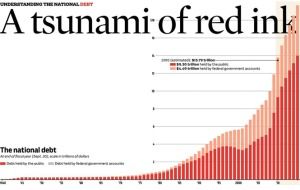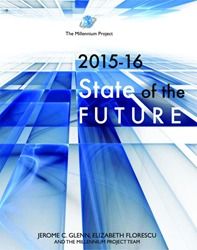“The nature of work, employment, jobs, and economics will have to change over the next 35 years, or the world will face massive unemployment by 2050. This was a key conclusion of the Future Work/Technology 2050 study published in the “2015−16 State of the Future.””
Category: policy – Page 78
At the end of 2015, the US national debt will be 18.6 trillion dollars. With such a big number, it’s tempting to put it in perspective by comparing it with things more easily envisioned.  Alas, I can not think of anything that puts such an oppressive and unfair burden into perspective, except to this:
Alas, I can not think of anything that puts such an oppressive and unfair burden into perspective, except to this:
US debt represents a personal obligation of $60,000 for each American citizen. And it is rising quickly. Most of our GDP is used simply to pay down interest on that debt. Few pundits see a way out of this hole.
 In my opinion, that hole was facilitated in August 1971, when the US modified the Bretton Woods Agreement and unilaterally terminated convertibility of the US dollar to gold. By forcibly swapping every dollar in every pocket and bank account with the promise of transient legislators, individual wealth was suddenly based on fiat instead of something tangible or intrinsic.
In my opinion, that hole was facilitated in August 1971, when the US modified the Bretton Woods Agreement and unilaterally terminated convertibility of the US dollar to gold. By forcibly swapping every dollar in every pocket and bank account with the promise of transient legislators, individual wealth was suddenly based on fiat instead of something tangible or intrinsic.
Feds Meet: No interest rate hike
The benchmark interest rate set by the US Federal Reserve Board is currently between 0 and 0.25%. It has been at or near zero since 2006.
By now, Lifeboat readers know that 20 hours ago, the US Federal Reserve board decided to not hike the benchmark interest rate. The Fed did, however, signal that they still intend to raise interest rates at a future meeting—perhaps in October or December.
The announcement came just after US equity markets closed. But, in what has become a most odd news coverage of a non-event, the immediate reaction was to lift the Asian stock markets, which were still open during the announcement.
I am a frequent contributor to Quora. I field many questions on economics, politics, law, and even physics. You might be inclined to check out my credentials as pundit of macro-economics. Don’t bother…There are none! I am an armchair economist (this is the same as saying: “I am not an economist”). But I certainly follow these things closely, and have an informed opinion.
Today, I was asked this:
What would happen if the fed had raised interest rates?
The question asked specifically about the effect on other interest rates, but a more interesting exercise might be to speculate on the state of the economy. Here then, is a comon-sense response…
If we could freeze all other conditions and avoid the effects of public confidence, likely change in debt, debt rating, etc… If we ignore these things, then the direct result of raising the interest rate for a given national currency is to attract outside money. That is, we would see an increase in foreign conversion into dollars and a movement of US assets from stocks and bonds into currency or currency equivalents. This is a simple result of the higher payout that one would expect after a raise in interest rates.
In theory, the sift of international assets and investment into dollars does four things:
- It strengthens the value of the dollar, thereby increasing the take-home potential of US workers and the number of things US residence buy from overseas (because a slightly higher fraction of organizations seek dollars)
- It increases income for anyone tied to published interest rates, such as many senior citizens.
- It increases interest payments from anyone tied to published interest rates. For anyone deeply in debt on instruments such as credit cards or home equity, this can have a devastating impact—causing minimum payments to rise by many times the interest rate hike.
- It increases US national debt, because so much of the economy is built on forward loans in the form of Treasury notes. With an interest rate increase, the US must pay more on both new debt and the financing of massive outstanding debts.
This is all theoretical, of course. In practice, one of the first effects is for individuals and institutions to wonder: “How can the US possibly pay out on debt at an increased rate?”. [possible answer]*
One very obvious effect is that many individuals will further lose confidence in the American economy or the will of American’s to honor the national debt. Because of this, the effect of raising the interest rate (for the first time in 9 years) is not easy to predict. Despite massive uptake on US debt, the Chinese and energy producing nations have limits to what they can believe. A subtle switch in their investment activity (or the determination to move away from a dollar-based reserve) will have massive repercussions, especially for the US.
_____________
* Some pundits argue that US debt and payments can continue to grow, because the ability to accommodate these things are protected by these things:
- a recovering economy
- increased activity from the new investors
- need for producer nations to seize on a massive consumer market
- need for producer nations to invest their gains
But, a growing number of economists, investors, analysts, credit bureaus, and citizens don’t buy this argument! They point out that it kicks-the-can down the road and foists untenable debt on future generations. They would prefer that the US reign in spending and pay down debt.
In this regard, being the world’s reserve currency has helped hook the US on debt, and it has ballooned out of control. Transitioning to a firmly capped currency that is not controlled by legislation or a reserve board would help the country avoid massive debts (those that exceed the willingness of bond holders to finance) and to do what it must do.
In my take, the real question is not “What if the Fed has raised interest rates?” The real question is:
Does the U.S. have the courage to link its currency to something durable
— and beyond control of transient political winds and a debt pyramid?”
Sure, we must still honor the excess of the past 40 years. But with gold, or Bitcoin, at least we will have solid underpinnings and incentives to spend within our means.
Philip Raymond is a member the New Money Systems Board
at Lifeboat. He is Co-chair of Cryptocurrency Standards
Association and editor at A Wild Duck.
It’s not every day you get to sit down and have a one-on-one conversation with a United States presidential candidate, let alone one who is also a Transhumanist. TechEmergence recently had the opportunity to do just that during an interview with Zoltan Istvan, the 2016 presidential candidate for the newly formed Transhumanist party and author of the 2013 published The Transhumanist Wager.
If you follow the emerging trends in artificial intelligence, then you have already likely heard of “Transhumanism.” Oxford’s Nick Bostrom, in his 2003 book Ethical Issues for the 21st Century, defined Transhumanism as “a loosely defined movement…that promotes an interdisciplinary approach to understanding and evaluating the opportunities for enhancing the human condition and the human organism opened up by the advancement of technology.”
This philosophy could be a turning point in human evolution. But like all great movements, this one is seemingly slow to pick up a serious following (though perhaps in retrospect, we will comment on how quickly this direction moved society forward). Regardless, Zoltan Istvan is determined to usher in this transitional philosophy as a political player and advocate for human enhancement.
Fighting for Our Lives
How do you get the populace, and other governments, to listen to ideas that, by mainstream standards, buck tradition and fall on the extreme side of the socially-acceptable spectrum?
Extending human life to hundreds of years, genetic enhancements to prevent disease or enhance human senses or mental capacities, and the potential to “back up” our memories (or our consciousness itself) — these are not “normal” American political concerns — but they’re regular topics of debate among Transhumanists.
There never seems to be an easy answer. As terrible as the idea is in its ramifications, society at large is prone to those life-changing moments in history, the “Pearl Harbor moments”, which seem to evoke the most devastating and poignant calls to action on a grand scale. With the ominous discussions that have been taking place around AI recently, we can only bite our nails at the thought of an AI-induced tragedy – one from which we may not be able to recover. Istvan aims to bring the topics of AI, biotechnology and human enhancement to the forefront of public consideration in order to guide the technology for good, before it “goes rogue.”
The Transhumanist Wave
“Transhumanism is slowly starting to engulf everyone, it’s part of an exploding interest”, remarks Zoltan. “We’ve been talking life extension, bionic arms, telepathy for a while, but for most of the last 50 years it was sci-fi…but over (the last) 48 months many people have crossed over and said, this is real now.”
Indeed, all of these technologies – telepathy included – are a part of our present and near-future realities (or are at least being actively researched). Life extension is one of the most talked about crossovers. Istvan has a distinct philosophy on this issue. “150,000 people a day die. I think that’s completely needless. I think if we have the proper technology…increased development of life extension technologies…would be able to save huge amounts of people over a decade,” a number that would likely equate to hundreds of millions of lives.
Zoltan comments on the promotion of “productive life hours, happy life hours”. He explains that part of the Transhumanist mission is trying to get people to understand that dying is not a good thing, to overcome what he sees as a history of being “trained to die”. Benjamin Franklin certainly spoke a relative truth when he commented that the only things certain in life are “death and taxes”. While we may not be close to escaping taxes, perhaps death can, in time, be conquered to a great extent. With investment in the right technology, society might soon be able to expand life spans to 120 or even 150 years.
The investment required is substantial. One of Istvan’s main agendas is in trying to convince people that the life extension initiative is more important than “buying trinkets at Walmart”. In other words, we need to move from being a complacent, ever-present society to being a proactive, forward-thinking one in order for life-extension technology to advance.
To be sure, there are a number of billionaires interested in living indefinitely, but what does that mean for the rest of us? Would the common person ever be able to afford such “extensions”, or would these technologies become advanced and cheap enough in time that they become the norm for almost all? Whether we like it or not, Istvan insists the shift towards this technology is already happening. The Transhumanist party was formed to try and make that shift quicker.
Zoltan is so confident in the output of potential investment that he is advocating for one trillion dollars in life-extension science (he remarks that the worlds’ governments’ net worth is 400 trillion total, though this number could not be verified). “I’m sure we can change the industry,” Istvan comments, “governments are just not interested (now) in keeping people alive…it’s a true tragedy.” Harkening to the importance of life extension many times in the recent full interview, it became evident as one of the major thrusts of his initiatives as an aspiring president.
Technology flits by right under our noses as we stare into our mobile phones, yet the far-reaching ideas of its evolving presence are scary. Tinkering with the human condition is…well, scary. Istvan recognizes these very normal fears, but he is leading a party and movement that emphasizes the overwhelming benefits that technology can offer, particularly in the area of human enhancement.
The traditional framing of the issue is a choice between accepting the power of markets and ‘playing their game’ to win environmental concessions vs. the purist perspective of saying No to any hint of money or markets in environmental policy.
In this article we will describe the positions of two relatively new fields of study—Ecological Economics and Political Ecology—in an effort to redefine the terms of the choice and chart a path for a pragmatic approach.
Washington, DC (PRWEB) June 30, 2015
Another 2.3 billion people are expected to be added to the planet in just 35 years. “By 2050, new systems for food, water, energy, education, health, economics, and global governance will be needed to prevent massive and complex human and environmental disasters,” explains Jerome Glenn, CEO of The Millennium Project. As Pope Francis said in His Encyclical Letter, “Halfway measures simply delay the inevitable disaster.”
The “2015−16 State of the Future” reviews the global situation and future prospects in a broad range of areas from environment to business and technology, and global ethics. Its executive summary states that:
“The Millennium Project’s futures research shows that most of these problems are preventable and a far better future than today is possible. Brilliant insights, policy and social innovations, scientific and technological breakthroughs, and new kinds of leadership are emerging around the world. The interactions among future artificial intelligences, countless new lifeforms from synthetic biology, proliferation of nano-molecular assemblies, and robotics could produce a future barely recognizable to science fiction today.
The future can be much better than most pessimists understand, but it could also be far worse than most optimists are willing to explore. We need serious, coherent, and integrated understandings of mega-problems and opportunities to identify and implement strategies on the scale necessary to address global challenges. This report should be used as a reference to further that understanding.”
The “2015−16 State of the Future” contains sections on 15 Global Challenges, a State of the Future Index that assesses where humanity is winning and losing, and a special study on “Future Work/Technology 2050.”
“After 18 years of producing the “State of the Future” reports, it is increasingly clear that humanity has the resources to address its global challenges,” says Elizabeth Florescu, Director of Research for The Millennium Project, “but it is not clear that an integrated set of global and local strategies will be implemented together timely enough and on the scale necessary to build a better future.”
The Millennium Project is a global participatory think tank connecting 56 Nodes around the world that identify important long-range challenges and strategies, and initiate and conduct foresight studies, workshops, symposiums, and advanced training. Its mission is to improve thinking about the future and make it available through a variety of media for feedback to accumulate wisdom about the future for better decisions today. It produces the annual “State of the Future” reports, the “Futures Research Methodology” series, the Global Futures Intelligence System (GFIS), and special studies. Over 4,500 futurists, scholars, business planners, and policy makers who work for international organizations, governments, corporations, NGOs, and universities have participated in The Millennium Project’s research since its inception, in 1992. The Millennium Project was selected among the top ten think tanks in the world for new ideas and paradigms by the 2013 and 2014 University of Pennsylvania’s GoTo Think Tank Index, and 2012 Computerworld Honors Laureate for its contributions to collective intelligence systems.
In 2014, I submitted my paper “A Universal Approach to Forces” to the journal Foundations of Physics. The 1999 Noble Laureate, Prof. Gerardus ‘t Hooft, editor of this journal, had suggested that I submit this paper to the journal Physics Essays.
My previous 2009 submission “Gravitational acceleration without mass and noninertia fields” to Physics Essays, had taken 1.5 years to review and be accepted. Therefore, I decided against Prof. Gerardus ‘t Hooft’s recommendation as I estimated that the entire 6 papers (now published as Super Physics for Super Technologies) would take up to 10 years and/or $20,000 to publish in peer reviewed journals.
Prof. Gerardus ‘t Hooft had brought up something interesting in his 2008 paper “A locally finite model for gravity” that “… absence of matter now no longer guarantees local flatness…” meaning that accelerations can be present in spacetime without the presence of mass. Wow! Isn’t this a precursor to propulsion physics, or the ability to modify spacetime without the use of mass?
As far as I could determine, he didn’t pursue this from the perspective of propulsion physics. A year earlier in 2007, I had just discovered the massless formula for gravitational acceleration g=τc^2, published in the Physics Essays paper referred above. In effect, g=τc^2 was the mathematical solution to Prof. Gerardus ‘t Hooft’s “… absence of matter now no longer guarantees local flatness…”
Prof. Gerardus ‘t Hooft used string theory to arrive at his inference. Could he empirically prove it? No, not with strings. It took a different approach, numerical modeling within the context of Einstein’s Special Theory of Relativity (STR) to derive a mathematic solution to Prof. Gerardus ‘t Hooft’s inference.
In 2013, I attended Dr. Brian Greens’s Gamow Memorial Lecture, held at the University of Colorado Boulder. If I had heard him correctly, the number of strings or string states being discovered has been increasing, and were now in the 10500 range.
I find these two encounters telling. While not rigorously proved, I infer that (i) string theories are unable to take us down a path the can be empirically proven, and (ii) they are opened ended i.e. they can be used to propose any specific set of outcomes based on any specific set of inputs. The problem with this is that you now have to find a theory for why a specific set of inputs. I would have thought that this would be heartbreaking for theoretical physicists.
In 2013, I presented the paper “Empirical Evidence Suggest A Need For A Different Gravitational Theory,” at the American Physical Society’s April conference held in Denver, CO. There I met some young physicists and asked them about working on gravity modification. One of them summarized it very well, “Do you want me to commit career suicide?” This explains why many of our young physicists continue to seek employment in the field of string theories where unfortunately, the hope of empirically testable findings, i.e. winning the Noble Prize, are next to nothing.
I think string theories are wrong.
Two transformations or contractions are present with motion, Lorentz-FitzGerald Transformation (LFT) in linear motion and Newtonian Gravitational Transformations (NGT) in gravitational fields.
The fundamental assumption or axiom of strings is that they expand when their energy (velocity) increases. This axiom (let’s name it the Tidal Axiom) appears to have its origins in tidal gravity attributed to Prof. Roger Penrose. That is, macro bodies elongate as the body falls into a gravitational field. To be consistent with NGT the atoms and elementary particles would contract in the direction of this fall. However, to be consistent with tidal gravity’s elongation, the distances between atoms in this macro body would increase at a rate consistent with the acceleration and velocities experienced by the various parts of this macro body. That is, as the atoms get flatter, the distances apart get longer. Therefore, for a string to be consistent with LFT and NGT it would have to contract, not expand. One suspects that this Tidal Axiom’s inconsistency with LFT and NGT has led to an explosion of string theories, each trying to explain Nature with no joy. See my peer-reviewed 2013 paper New Evidence, Conditions, Instruments & Experiments for Gravitational Theories published in the Journal of Modern Physics, for more.
The vindication of this contraction is the discovery of the massless formula for gravitational acceleration g=τc^2 using Newtonian Gravitational Transformations (NGT) to contract an elementary particle in a gravitational field. Neither quantum nor string theories have been able to achieve this, as quantum theories require point-like inelastic particles, while strings expand.
What worries me is that it takes about 70 to 100 years for a theory to evolve into commercially viable consumer products. Laser are good examples. So, if we are tying up our brightest scientific minds with theories that cannot lead to empirical validations, can we be the primary technological superpower a 100 years from now?
The massless formula for gravitational acceleration g=τc^2, shows us that new theories on gravity and force fields will be similar to General Relativity, which is only a gravity theory. The mass source in these new theories will be replaced by field and particle motions, not mass or momentum exchange. See my Journal of Modern Physics paper referred above on how to approach this and Super Physics for Super Technologies on how to accomplish this.
Therefore, given that the primary axiom, the Tidal Axiom, of string theories is incorrect it is vital that we recognize that any mathematical work derived from string theories is invalidated. And given that string theories are particle based theories, this mathematical work is not transferable to the new relativity type force field theories.
I forecast that both string and quantum gravity theories will be dead by 2017.
When I was seeking funding for my work, I looked at the Broad Agency Announcements (BAAs) for a category that includes gravity modification or interstellar propulsion. To my surprise, I could not find this category in any of our research organizations, including DARPA, NASA, National Science Foundation (NSF), Air Force Research Lab, Naval Research Lab, Sandia National Lab or the Missile Defense Agency.
So what are we going to do when our young graduates do not want to or cannot be employed in string theory disciplines?
(Originally published in the Huffington Post)
Recent revelations of NASA’s Eagleworks Em Drive caused a sensation on the internet as to why interstellar propulsion can or cannot be possible. The nay sayers pointed to shoddy engineering and impossible physics, and ayes pointed to the physics of the Alcubierre-type warp drives based on General Relativity.
So what is it? Are warp drives feasible? The answer is both yes and no. Allow me to explain.
The empirical evidence of the Michelson-Morley experiment of 1887, now known as the Lorentz-FitzGerald Transformations (LFT), proposed by FitzGerald in 1889, and Lorentz in 1892, show beyond a shadow of doubt that nothing can have a motion with a velocity greater than the velocity of light. In 1905 Einstein derived LFT from first principles as the basis for the Special Theory of Relativity (STR).
So if nothing can travel faster than light why does the Alcubierre-type warp drive matter? The late Prof. Morris Klein explained in his book, Mathematics: The Loss of Certainty, that mathematics has become so powerful that it can now be used to prove anything, and therefore, the loss of certainty in the value of these mathematical models. The antidote for this is to stay close to the empirical evidence.
My good friend Dr. Andrew Beckwith (Prof., Chongqing University, China) explains that there are axiomatic problems with the Alcubierre-type warp drive theory. Basically the implied axioms (or starting assumptions of the mathematics) requires a multiverse universe or multiple universes, but the mathematics is based on a single universe. Thus even though the mathematics appears to be sound its axioms are contradictory to this mathematics. As Dr. Beckwith states, “reducto ad absurdum”. For now, this unfortunately means that there is no such thing as a valid warp drive theory. LFT prevents this.
For a discussion of other problems in physical theories please see my peer reviewed 2013 paper “New Evidence, Conditions, Instruments & Experiments for Gravitational Theories” published in the Journal of Modern Physics. In this paper I explain how General Relativity can be used to propose some very strange ideas, and therefore, claiming that something is consistent with General Relativity does not always lead to sensible outcomes.
The question we should be asking is not, can we travel faster than light (FTL) but how do we bypass LFT? Or our focus should not be how to travel but how to effect destination arrival.
Let us take one step back. Since Einstein, physicists have been working on a theory of everything (TOE). Logic dictates that for a true TOE, the TOE must be able to propose from first principles, why conservation of mass-energy and conservation of momentum hold. If these theories cannot, they cannot be TOEs. Unfortunately all existing TOEs have these conservation laws as their starting axioms, and therefore, are not true TOEs. The importance of this requirement is that if we cannot explain why conservation of momentum is true, like Einstein did with LFT, how do we know how to apply this in developing interstellar propulsion engines? Yes, we have to be that picky, else we will be throwing millions if not billions of dollars in funding into something that probably won’t work in practice.
Is a new physics required to achieve interstellar propulsion? Does a new physics exists?
In 2007, after extensive numerical modeling I discovered the massless formula for gravitational acceleration, g=τc^2, where tau τ is the change in the time dilation transformation (dimensionless LFT) divided by that distance. (The error in the modeled gravitational acceleration is less than 6 parts per million). Thereby, proving that mass is not required for gravitational theories and falsifying the RSQ (Relativity, String & Quantum) theories on gravity. There are two important consequences of this finding, (1) we now have a new propulsion equation, and (2) legacy or old physics cannot deliver.
But gravity modification per g=τc^2 is still based on motion, and therefore, constrained by LFT. That is, gravity modification cannot provide for interstellar propulsion. For that we require a different approach, the new physics.
At least from the perspective of propulsion physics, having a theoretical approach for a single formula g=τc^2 would not satisfy the legacy physics community that a new physics is warranted or even exists. Therefore, based on my 16 years of research involving extensive numerical modeling with the known empirical data, in 2014, I wrote six papers laying down the foundations of this new physics:
1. “A Universal Approach to Forces”: There is a 4th approach to forces that is not based on Relativity, String or Quantum (RSQ) theories.
2. “The Variable Isotopic Gravitational Constant”: The Gravitational Constant G is not a constant, and independent of mass, therefore gravity modification without particle physics is feasible.
3. “A Non Standard Model Nucleon/Nuclei Structure”: Falsifies the Standard Model and proposes Variable Electric Permittivity (VEP) matter.
4. “Replacing Schrödinger”: Proposes that the Schrödinger wave function is a good but not an exact model.
5. “Particle Structure”: Proposes that the Standard Model be replaced with the Component Standard Model.
6. “Spectrum Independence”: Proposes that photons are spectrum independent, and how to accelerate nanowire technology development.
This work, published under the title Super Physics for Super Technologies is available for all to review, critique and test its validity. (A non-intellectual emotional gut response is not a valid criticism). That is, the new physics does exist. And the relevant outcome per interstellar propulsion is that subspace exists, and this is how Nature implements probabilities. Note, neither quantum nor string theories ask the question, how does Nature implement probabilities? And therefore, are unable to provide an answer. The proof of subspace can be found in how the photon electromagnetic energy is conserved inside the photon.
Subspace is probabilistic and therefore does not have the time dimension. In other words destination arrival is not LFT constrained by motion based travel, but is effected by probabilistic localization. We therefore, have to figure out navigation in subspace or vectoring and modulation. Vectoring is the ability to determine direction, and modulation is the ability to determine distance. This approach is new and has an enormous potential of being realized as it is not constrained by LFT.
Yes, interstellar propulsion is feasible, but not as of the warp drives we understand today. As of 2012, there are only about 50 of us on this planet working or worked towards solving the gravity modification and interstellar propulsion challenge.
So the question is not, whether gravity modification or interstellar propulsion is feasible, but will we be the first nation to invent this future?
(Originally published in the Huffington Post)
“The ethics of encountering non-sentient alien life in our solar systems boils down to a core dilemma, says Waller. ‘Is it about conservation and preservation? Or is it about our needs, wants, and desires?’ On Earth, natural-resource grabs have a history of bringing out the worst in us as a species…There’s plenty of reason to believe other planets will be chock-full of resources we’d like to exploit, even if the life forms are microbial – perhaps especially if they’re microbial.” Read more
“Instead of treating Amsterdam as complete and starting again elsewhere, the IJburg plan has managed to find more space in a city that thought it had no more left.”




